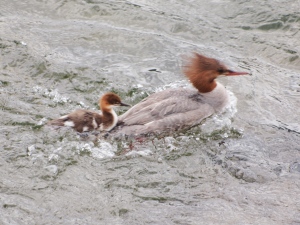Common Merganser Family Values
Common Mergansers are a common sight in winter but their behaviour is anything but common. They submerge their heads and look underwater for prey before diving and swimming in pursuit. If you are lucky, you might see them emerge with a fish, or maybe a frog. Like most ducks, the female raises the brood. The male leaves once the female is no longer “fertile” and when she starts incubating the eggs. Common Mergansers often nest in tree cavities, but may occasionally nest on the ground. The pictures of the male and female I posted here may be of a pair establishing a ground nest.
Females lay several eggs and sometimes you see a huge Common Merganser brood – I have seen 13 chicks with one female. But many of the chicks may belong to another hen. The females may dump eggs into a nest that isn’t her own – “egg dumping”. Merganser chicks may join another brood if they become separated from the hen. I once saw merganser chicks emerge from a nesting box and land, one after the other in the water below to join the hen who was calling below. What a way to come into the world – a leap into space and then a splash. And then swimming for your life to join your mother and your siblings.
This past summer I saw an eagle hovering over a stream and when I went closer to investigate I saw a merganser and her brood scurrying for cover in the shrubs along the bank. When I returned an hour or so later, the eagle and the merganser brood were gone. I could hear a persistent cheeping however, and I saw a single merganser chick standing on a log and calling. Eventually the chick swam over to a mallard brood, calling loudly the whole time. The mallard stayed between her own brood and the merganser chick, but did not peck at or chase the chick away. Eventually, she seemed to accept the merganser chick as a neighbour, if not part of her brood. I have no idea of the outcome. Perhaps the merganser brood came back that way and the chick found its family again, or maybe not. But the chick’s willingness to join up with another brood is an interesting survival mechanism.
Why take on so many young? Common Merganser chicks are precocial – they can swim, follow the female and feed themselves almost as soon as they hatch. They stick very close to the female and to each other. The female may not feed the brood, but she does lead them to food and safety. Chicks also seek to ride on the back of the female – making it easier to stay with her when they are young. So “adopting” chicks probably does not affect the hen’s survival, nor that of her own chicks. And perhaps egg dumping and adoption is a strategy that increases the likelihood of her own genes surviving – her own chicks are as likely to get lost, or she may need to dump eggs into another nest herself. Perhaps most of the females in small forest lakes where they nest are related. Maybe the costs of adoption are small and the likelihood of promoting the survival of your own genes high. Who knows? But it is an interesting question.
Winter life for Common Mergansers seems to consist of fishing and avoiding eagles and other predators. Once spring comes, they will seek mates and disappear into the wooded wetlands where they can find nesting sites and safely raise a brood of young. I wonder how many of the birds I see now were “adopted” or are the product of a “dumped” egg? I wonder if it affects their own nesting behaviour (are the young of “egg-dumpers” more likely to dump their own eggs?). There is so much we don’t understand about the birds we see. What an intricate and wonderful world we live in!

A “photo-shopped” photo of a common merganser with chicks on her back. The original photo was not sharp – due to the distance.
all photos and writing copyright J.A. Siderius 2013.




